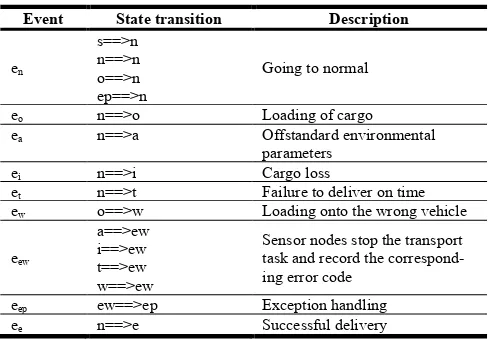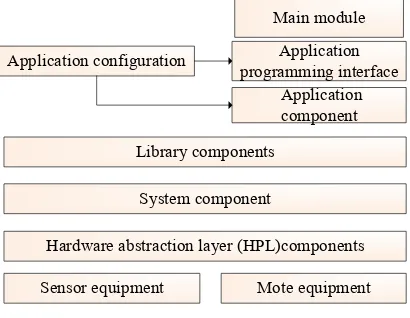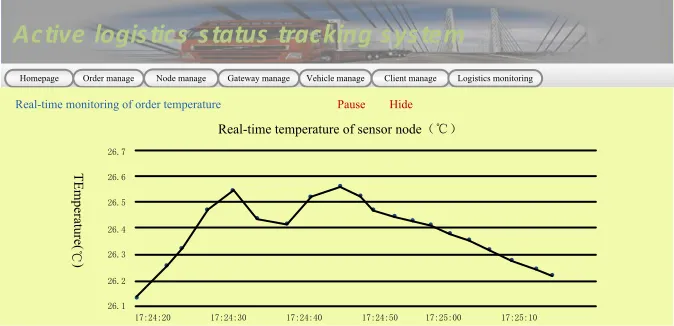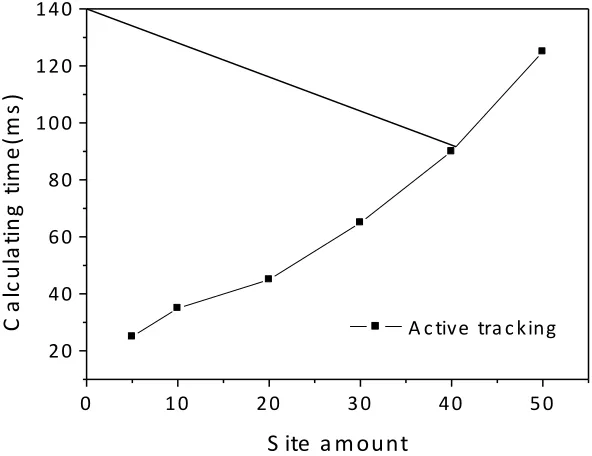A Logistics Status Real-time Tracking System
Based on Wireless Sensor Network
https://doi.org/10.3991/ijoe.v14i05.8641
Zeyun Chen
Sichuan Vocational and Technical College of Communications, China 11242297@qq.com
Abstract—The progress in the economic society has driven the rapid devel-opment of the logistics industry. In the face of increasingly enormous and com-plicated logistics systems, it is of great practical significance to study how to ef-fectively control the logistics process, minimize the labour cost and provide re-al-time monitoring data for users. For this purpose, this paper designs an active logistics status tracking (ALST) system platform based on Wireless sensor net-work (WSN). This paper, by fully integrating the characteristics of WSN, de-signs the system architecture based on the design philosophy of active logistics status tracking method; it also constructs and realizes the hardware function modules such as wireless sensor node, vehicle gateway, user terminal and backend server etc., and adopts the finite-state machine (FSM)-based active tracking model to maintain the logistics object status; and then it carries out programming of wireless sensor node active state tracking in TinyOS2.x, and finally performs system test under normal operation. The active logistics status tracking system can be widely applied in the logistics industry, to optimize the logistics process, reduce losses and improve logistics operation efficiency.
Keywords—wireless sensor network (WSN), active logistics status tracking (ALST), finite-state machine (FSM), tinyos.2
1
Introduction
capacity. In this paper, the author designs an active logistics status tracking (ALST) system by fully utilizing various advantages of the WSN technology.
2
Key Technologies for System Design
2.1 FSM-based active tracking model
Finite-state machine (FSM) means the finite state set, and the mathematical model of the behaviours between these states such as transfer and motion etc; the object only remains in a specific state at any time [5-6]. In any state, if some event occurs, it will select a method to solve it or determine whether to transfer it to the next state based on the difference between the current state and the input event.
M=( N, L, F, S, Z) is generally used: the state list N is a finite state set; the in-put event list L is the set of all received events in the system; the state shift function F defines the state transition logic; the initial state S is a special state of the system; and the termination state is a sub-set of N [7-9].
2.2 FSM-based active tracking system in logistics context
To apply FSM in managing the state of logistics object in logistics context and re-alize the ALST, the primary step is to determine the states and events of the objects and their relationships in the logistics process [10-12]. The possible states of every logistics object in the logistics process are given as follows: initial state (s), termina-tion state (e), normal state (n), vehicle loading (o), unqualified environment indicator, delayed delivery (t), cargo loss (i), wrong loading (w), waiting process (ew), and exception handling.
In the logistics process, events means some possible changes of the objective envi-ronment condition, transport route and loading/unloading, e.g. loading onto the wrong vehicle, cargo loss or unqualified environment parameters. The FSM can describe the relationships between the logistics states and events for the object in the logistics process. Table 1 lists the possible events in the logistics process.
Table 1. List of events in the logistics process Event State transition Description
en
s==>n n==>n o==>n ep==>n
Going to normal
eo n==>o Loading of cargo
ea n==>a Offstandard environmental
parameters
ei n==>i Cargo loss
et n==>t Failure to deliver on time
ew o==>w Loading onto the wrong vehicle
eew
a==>ew i==>ew t==>ew w==>ew
Sensor nodes stop the transport task and record the correspond-ing error code
eep ew==>ep Exception handling
ee n==>e Successful delivery
2.3 Rule-based event processing and decision-making
Describing the event processing and decision-making by rule can ensure the wire-less sensor nodes will make the event processing and decision-making after collecting the original logistics data, and then the FSM will implement relevant state transition, for the purpose of active status tracking [13-15]. The rule-based event processing and decision-making module consists of a sensor, rule description, a rule interpreting engine, configuration, a commander interpreter, and a storage. The format of rule includes series number, type, logic condition, minimum value, maximum value and motion. Every rule states the decisive-making behaviour in a specific state upon the occurrence of a specific event.
3
Active Logistics Status Tracking (ALST) System Design
Based on Wireless Sensor Network (WSN)
3.1 Design philosophy
Fig. 1. Comparison between centralized logistics tracking and active logistics status tracking
Decentralized control and optimization: the ALST method has endowed the logis-tics object with certain intelligence; with the support of WSN, every logislogis-tics object can autonomously search for information and make decisions and determine the next motion before exiting the logistics process.
Local information processing: the ALST transfers the logistics logic task originally in the backend server to the wireless sensor nodes, makes use of the data processing ability of the wireless sensor nodes to process the logistics information and turns the backend server off.
Active decision execution: the ALST adopts active decision execution; after local information processing by the wireless sensor nodes, proper decisions can be made, effectively improving the instantaneity of decision execution.
3.2 System structure and function modules
System structure. The system architecture is shown as below:
The WSN-based active logistics state tracking system architecture consists of a warehouse gateway, a vehicle gateway, sensor nodes, an office terminal and a client terminal.
client terminal
Vehicle gateway office terminal
back-end server
cargo
truck warehouse gateway sensor
node Internet
Internet Internet
GPS/GPRS
Fig. 2. System architecture diagram
Function modules. Based on the system structure, different modules are designed, including the wireless sensor node function module, vehicle gateway function ule, warehouse gateway function module and back-end server module. The first mod-ule, i.e. the wireless sensor node function module is described in detail below.
As the ultimate carrier of ALST, the wireless sensor nodes make use of their per-ceptual abilities to perceive the surrounding environment of the cargo, obtain logistics data such as related environmental parameters, etc., and then carry out relevant event processing and decision-making with their computing power, to further control the logistics transportation process of the object, and fulfil the ALST. The sub-modules of the wireless sensor node function module are shown below;
finite state machine
time processing and decision making wireless sensor node
data collection
data store data forwarding
Fig. 3. Diagram of the wireless sensor node function module
rela-tionship between event and state in the logistics process, with the occurrence of a specific event for the logistics object in a specific state, the wireless sensor node can skip to relevant state, so as to complete the state tracking of the logistic object in transport; this module also executes the control program.
Event processing and decision-making module: it makes event processing and de-cision execution of the logistics data collected by the data collecting sub-module. It returns the analytic results to the FSM sub-module, which then carries out state transi-tion accordingly, in order to maintain the state of logistics object.
Data collection submodule: it collects data from various sensors such as tempera-ture, humidity, vibration and infrared light sensors etc.; and then it goes back to main control submodule after data collection.
Data memory submodule: it carries out read-write operations in the flash storage for wireless sensor nodes.
Data transmission submodule: it controls the data communication between wireless sensor nodes and sensor gateway.
3.3 Business process analysis
Begin
Read node flash data
Is it initialized?
Dormant(Wait for the initialization data to arrive)
Writes the initialization data to flash
Dormant
Arouse?
Node alarm Determine if the vehicle is correct
Data acquisition
Event handling
Event occurrence?
Executive decisions
State transition
End
End The initialization data is
coming,or not?
Yes No
Yes No
No
No Yes
Yes
Yes No
Fig. 4. Active status tracking flow chart
1. Initialization of the sensor node: The warehouse gateway converts orders into
binary data, and writes the data into the base node; through wireless communica-tion, the base node transfers the data to the sensor node, which inputs the data into the Flash, and then completes the initialization; and then the sensor node enters the dormant state.
2. Vehicle loading: The sensor node in the dormant state is placed in the package and
then loaded in the vehicle; after the vehicle gateway sends a message to the sensor node, the sensor node sends back the ACK to the vehicle gateway; then the regis-tration is finished And the sensor node is ready to work.
3. Determine whether the object is loaded onto the wrong vehicle: Aroused by the
vehicle gateway, the wireless sensor node communicates with vehicle gateway to acquire the vehicle information, and then compares the acquired information with that obtained at the initialization stage, checks whether the information is con-sistent, and determines whether the logistics object is loaded onto the wrong vehi-cle.
4. Periodic collection of logistics data: The wireless sensor node executes its
logis-tics collection task, and with its perception ability, periodically perceives the sur-rounding environments such as temperature, humidity, geographical location and vehicle information, so as to obtain the logistics data.
5. Event processing: After data collection, the wireless sensor node makes relevant
decision analysis and judgments on the collected logistics data, including the envi-ronment.
6. Decision Execution: End
4
System Implementation and Test
The wireless sensor node module is the key for system implementation. This paper puts emphasis on the implementation of the wireless sensor node in the TinyOS plat-form, and performs test on the system.
4.1 Wireless sensor node module
Implementation environment. The development environment of the system is given in Table 2:
Table 2. System development environment
Name Configuration
Wireless sensor node model IRIS-XM2110
Programming board MIB520
Node operating environment TinyOS 2.x[38]
In this paper, the author selected the IRIS intelligent node of Crossbow as the wire-less sensor node, and also the MIB 520 programming of Crossbow, and adopted the TinyOS 2.x operation system for the wireless sensor node, and the XP operation sys-tem for the PC programming environment; nesC language was taken as the program-ming language, and the programme was transcribed into the IRIS node after being compiled by related commands.
Component-based program model. TinyOS consists of a dispatcher and a series of components; the TinyOS-based program model is shown as below:
Application configuration
Main module Application programming interface
Application component Library components
System component
Hardware abstraction layer (HPL)components
Sensor equipment Mote equipment
Fig. 5. The program model of TinyOS
The node hardware, located in the bottom layer, is designed for implementing all hardware functions; the hardware abstraction layer (HAL) component is to encapsu-late the bottom layer hardware; the system component is to execute the services pro-vided to the components of the application layer; the library component provides the library function; the application component is used to implement specific functions; and the MAIN component is designed to initialize the hardware, start the task dis-patcher, and execute the initialization of the user component.
ALST Program structure. During the programming of the wireless sensor node ALST in TinyOS2.x, some built-in components can be directly applied; besides, the modules, including DataAcuisition, FSM and Datatransmission etc., should be written separately. This paper emphasizes the workflow and codes of the FSM module, be-cause it is the main control module of the whole program.
FSM, the infinite state machine module, can invoke other modules to serve the program; the workflow is given as follows:
1.Start the MainC module: start the control program;
2.Start the TimerMillic Timer: start the logistics task; and by starting the timer, start the periodic collection task;
3.Revoke the DataAcuisition Module: collect data from sensors, and then return var-ious data;
5.State transition: carry out state transition on the basis of processing results, and maintain the state of the wireless sensor node in the dynamic environment.
6.This paper captures the related codes in the FSM implementation process in the temperature collection period.
4.2 System test
System tests were conducted on the availability and performance of the ALST sys-tem based on WSN, to check whether the syssys-tem could fulfil the initial design objec-tive.
System functional test. The system functional test was mainly to check whether the wireless sensor node can actively track the logistics state of the object and help the logistics object complete the whole process. The test content included the tests on vehicle location information, real-time environmental data monitoring, event pro-cessing and decision making, and rule modification by commands. Take the real-time temperature monitoring test for example. The detailed description is shown below:
Homepage Order manage Node manage Gateway manage Vehicle manage Client manage Logistics monitoring
!"#$%&'()*$+#$"+'+#,#-+'#.,"/$0*'+1+#&2
Real-time monitoring of order temperature Pause Hide
Real-time temperature of sensor node
TEmperature(
)
Fig. 6. Temperature change curve test diagram
In this paper, a temperature sensor was adopted to test whether the wireless sensor node can make active tracking of the logistics object at different temperatures. In order to simulate the temperature variation in the real logistics environment, the tem-perature in the test environment was dynamically changed through manual control to test the response of the wireless sensor node. Fig 6 depicts the temperature data of the IRISA node over time, indicating that despite the dynamically changing temperature, the wireless sensor node could still stably transfer temperature data and collect data in real time, and provide real-time temperature data to the back-end server.
backend server, energy consumption of the wireless sensor node, decision response speed, and computing capacity of the wireless sensor node.
The computing capacity of the wireless sensor node was tested by analyzing the time taken by the wireless sensor nodes to calculate the delivery data of the logistics object; in the test, the calculation complexity could be adjusted by changing the num-ber of logistics sites in the system. Fig 7 depicts the time changing curve with the number of logistics sites, which shows the computation time of wireless sensor nodes increased with the number of logistics sites increasing. When the number of sites reaches a certain threshold, the wireless sensor nodes cannot perform the calculation, because the limited RAM space in the IRIS nodes is not enough to store excessive site data. In this case, it is necessary to distribute some calculation tasks to the backend server or sensor gateway, so as to ensure the overall performance of the system.
! "! #! $! %! &!
#! %! '! (! "!! "#! "%!
)
*+,
-+*
./0
12
./3
45
3
67
8 /.42*39-0.
2: ,./;42.<* ,=/01
2
2
Fig. 7. Calculation time of delivery data by wireless sensor nodes
The results show that the active status tracking method can: 1.Effectively reduce the data traffic in the logistics system; 2.Improve the response speed of the system in decision-making;
5
Conclusion
This paper, by fully integrating the characteristics of WSN, designs the system ar-chitecture based on the design philosophy of the active logistics status tracking meth-od.
It also constructs and realizes such hardware function modules as wireless sensor node, in-vehicle gateway, user terminal and backstage server etc.
It adopts the finite-state machine (FSM)-based active tracking model to maintain the logistics object; and then carries out programming of wireless sensor node active status tracking in TinyOS2. x.
Finally, this paper performs the system test under normal operation. The active lo-gistics status tracking system can be widely applied in the lolo-gistics industry, so as to optimize the logistics process, reduce losses and improve logistics operation efficien-cy.
6
References
[1] Kim, J.S., Lee, H.J., Oh, R.D. (2015). Smart integrated multiple tracking system develop-ment for iot based target-oriented logistics location and resource service. Journal of Hu-man Hypertension, 9(5), 195-204.
[2] Ha, S.C., Choi, J.E. (2002). A model design of the track & trace system for e-logistics. Operational Research, 2(1), 5-15. https://doi.org/10.1007/BF02940118
[3] Sang, H.W., Choi, J.Y., Kwak, C., Chang, O.K. (2009). An active product state tracking architecture in logistics sensor networks. Computers in Industry, 60(3), 149-160.
https://doi.org/10.1016/j.compind.2008.12.001
[4] Hilpert, H., Kranz, J., Schumann, M. (2013). Leveraging green is in logistics - developing an artifact for greenhouse gas emission tracking. Business & Information Systems Engi-neering, 5(5), 313-323. https://doi.org/10.1007/s12599-013-0285-1
[5] Li, Jianghai, Jia, Qing-Shan, Guan, Xiaohong, Chen, Xi. (2011). Tracking a moving object via a sensor network with a partial information broadcasting scheme. Information Scienc-es, 181(20), 4733-4753. https://doi.org/10.1016/j.ins.2011.06.006
[6] Liu, M., Li, H., Shen, Y., Fan, J., & Huang, S. (2009). Elastic neural network method for multi-target tracking task allocation in wireless sensor network. Computers & Mathematics with Applications, 57(11), 1822-1828. DOI: 10.1016/j.camwa.2008.10.050
https://doi.org/10.1016/j.camwa.2008.10.050
[7] Jung, W.S., Lim, K.W., Ko, Y.B., Park, S.J. (2011). Efficient clustering-based data aggre-gation techniques for wireless sensor networks. Wireless Networks, 17(5), 1387-1400.
https://doi.org/10.1007/s11276-011-0355-6
[8] Tran-Dang, H., Krommenacker, N., Charpentier, P. (2016). Containers monitoring through the physical internet: a spatial 3d model based on wireless sensor networks. International Journal of Production Research, 55(9), 2650-2663. https://doi.org/10.1080/00207 543.2016.1206220
[10] Xiao, X., He, Q., Li, Z., Antoce, A.O., Zhang, X. (2017). Improving traceability and trans-parency of table grapes cold chain logistics by integrating WSN and correlation analysis. Food Control, 73, 1556-1563. https://doi.org/10.1016/j.foodcont.2016.11.019
[11] Cardei, M., Du, D.Z. (2005). Improving wireless sensor network lifetime through power aware organization. Wireless Networks, 11(3), 333-340. https://doi.org/10.1007/s11276-005-6615-6
[12] Karaboga, D., Okdem, S., Ozturk, C. (2012). Cluster based wireless sensor network rout-ing usrout-ing artificial bee colony algorithm. Wireless Networks, 18(7), 847-860.
https://doi.org/10.1007/s11276-012-0438-z
[13] Jia, J., Chen, J., Chang, G., Wen, Y., Song, J. (2009). Multi-objective optimization for coverage control in wireless sensor network with adjustable sensing radius. Computers & Mathematics with Applications, 57(11-12), 1767-1775. https://doi.org/10.1016/j.camwa. 2008.10.037
[14] Carter, M.W., Jin, H.H., Saunders, M.A., Ye, Y. (2006). Spaseloc: an adaptive subproblem algorithm for scalable wireless sensor network localization. Siam Journal on Optimization, 17(4), 1102-1128. https://doi.org/10.1137/040621600
[15] Ting, C.K., Liao, C.C. (2010). A memetic algorithm for extending wireless sensor network lifetime. Information Sciences, 180(24), 4818-4833. https://doi.org/10.1016/j.ins. 2010.08.021
7
Author
Zeyun Chen graduated from Dalian Maritime University, and received the B.S. degree in management from Dalian Maritime University, Dalian, China, in 2003, and the M.S. degree in Logistics Engineering from Sichuan University, Chengdu, China, 2017. Since 2003, he has been on the faculty of Sichuan Vocational and Technical College of Communications. He is currently working toward the Ph.D. degree at Si-chuan University. His research interests include Logistics engineering, logistics in-formation technology.





